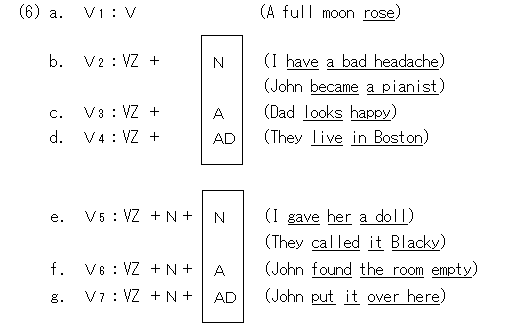|
Chapter II SENTENCE(S) |
|
|
Lesson 10 Verb Patterns
10-1 [Three Verb Patterns]
Verbs are of two kinds. One kind is made up of one word and can stand alone, while the other is always made up of two or more words.
(1) A full moon rose.
(2) a. *I have.
b. I have a headache.
The word "rose" in (1) can be called a verb(V) alone, because it completes in meaning by itself. The word "have" in (2a), however, can not be called a verb(V) because it is not complete in itself. Back in 5-2, we named this kind of word a verbalizer, VZ.Some verbalizers can be complete only when they go with two words or phrases.
(3) a. *I gave.
b. *I gave her.
c. I gave her a doll.
(4) a. *He put.
b. *He put a kettle.
c. He put a kettle on the fire.
To sum up, there are three verb patterns in English.
<Three Verb Patterns(to be revised)>
(5)a. V (0 slot) (ex. rise)
b. VZ + X (1 slot) (ex. have + X)
c. VZ + Y + Z (2 slots) (ex. give + Y + Z)
10-2 [Seven Verb Patterns] If we examine the verb patterns in (5), we find:
(i) Y is always a noun(N).
(ii) X and Z can be a noun(N), an adjective(A) or an adverb(AD).
This means that the three verb patterns in (5) can be revised in the following seven verb patterns.
<Seven Verb Patterns(revised)>
 10-3 [Diagrams]
(7) (rose)
V1
|
V
(rose)
(8) (have a bad headache/became a pianist)
V2
10-4 [Versatile Verbalizers] A verbalizer(VZ) may belong to more than one verb pattern.
(14) a. Mary kept a diary. (VZ+N)
b. Mary kept quiet. (VZ+A)
c. Mary kept her room neat and tidy. (VZ+N+A)
d. Mary kept her jewelry in a cookie jar. (VZ+N+AD)
These examples show that the verbalizer "keep" actually has four different meanings; so it has four verb patterns.Another example.
(15) a. Nobody could read and write there. (V)
b. Do you often write home? (V)
c. The child wrote a big "M" on the road. (VZ+N)
d. This pen writes well. (VZ+AD)
|
|
Copyright(C) 2004 Masaya Oba. All rights reserved. |
|